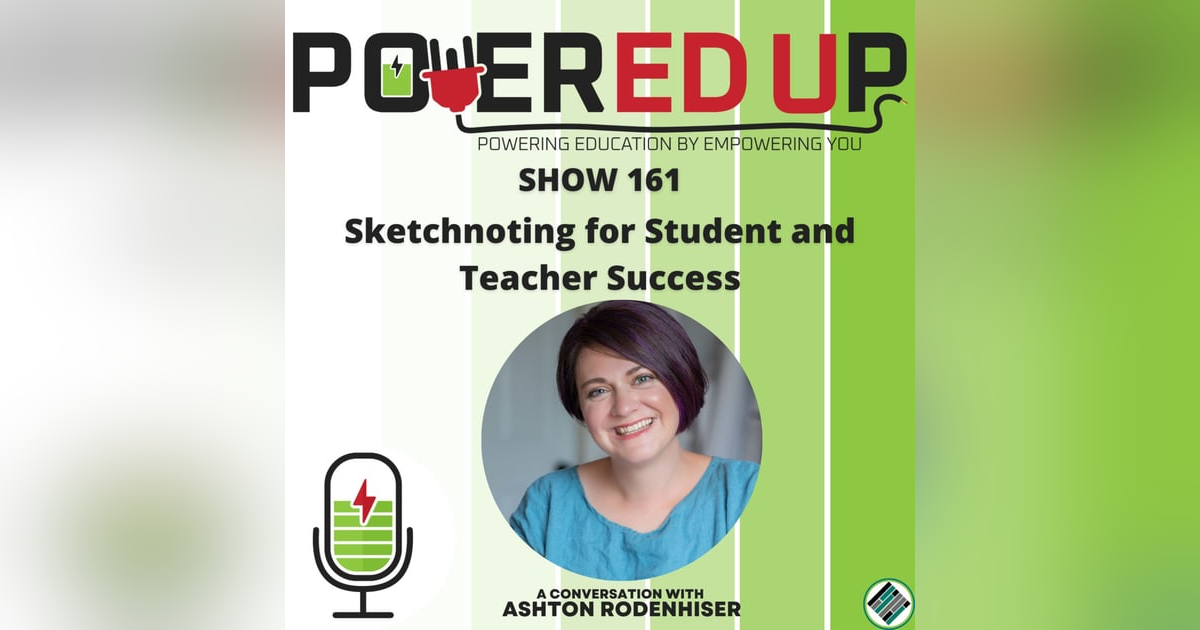161: Sketchnoting for Student and Teacher Success

Summary
Ashton Rodenhiser, a professional live illustrator and graphic facilitator, discusses the power of visual communication and the process of graphic facilitation. She explains how she got into graphic facilitation and the tools she uses for her work. Ashton also introduces the concept of sketchnoting and shares how it can be taught to students. She emphasizes the importance of providing students with the freedom to doodle and draw while setting parameters to ensure the focus remains on learning. Ashton highlights the benefits of sketchnoting, including improved retention of information and the ability to make connections. In this conversation, Ashton Rodenhiser discusses the benefits of sketchnoting in the classroom and provides practical advice for teachers. She emphasizes the importance of allowing students the opportunity to sketchnote and encourages teachers to change their delivery of information to promote thinking and visual processing. Ashton also highlights the flexibility of sketchnoting and the various ways it can be incorporated into different subjects. She suggests celebrating and supporting all forms of creativity and advises teachers to persevere through rejection and reconnect with their why to overcome moments of stress. Ashton concludes by recommending her book, 'The Beginner's Guide to Sketchnoting,' and inviting teachers to join the sketchnoting community at sketchnote.school.
Takeaways
Graphic facilitation involves creating visual representations of conversations and group processes.
Sketchnoting is a form of visual note-taking that can help improve retention of information and make connections.
Teachers can introduce sketchnoting to students by teaching basic drawing elements and encouraging them to use lines, shapes, and icons to represent information.
Doodling and sketchnoting can enhance learning and focus, but it's important to set expectations and parameters to ensure the focus remains on the content being learned. Encouraging students to sketchnote can enhance their learning experience by promoting visual thinking and processing.
Changing the delivery of information to a more creative and storytelling format can engage students and encourage deeper understanding.
Sketchnoting can be applied in various subjects and can be adapted to suit different learning styles and preferences.
Balancing creativity and productivity is important when incorporating sketchnoting in the classroom.
Embracing imperfection and understanding that sketchnoting skills develop over time can help teachers and students overcome self-doubt and fear of rejection.
Teachers can find resources and support for learning and implementing sketchnoting in the book 'The Beginner's Guide to Sketchnoting' and the sketchnoting community at sketchnote.school.
Chapters
00:00 Introduction and Background
02:10 Facilitation and Graphic Facilitation
06:14 Process of Graphic Facilitation
10:45 Tools and Setup for Graphic Facilitation
14:22 The Power of Visual Communication
16:06 Introduction to Sketchnoting
19:21 Teaching Sketchnoting to Students
29:49 Encouraging Doodling and Sketchnoting
36:51 Benefits and Applications of Sketchnoting
41:06 Encouraging Students to Sketchnote
42:04 Changing Delivery of Information
43:03 Creating an Environment for Visual Thinking
44:39 Applying Sketchnoting in Different Subjects
45:34 Balancing Creativity and Productivity
46:21 Different Approaches to Sketchnoting
49:14 Flexibility in Sketchnoting
50:36 The Best Thing a Teacher Can Do
52:42 Overcoming Stress as an Educator
55:21 Advice for Teachers Trying Sketchnoting
57:32 Embracing Imperfection in Sketchnoting
58:27 Resources for Learning Sketchnoting
Twitter: @mindseyeccf
Help us out!
Help us reach new listeners on iTunes by leaving us a rating and review! It takes just 30 seconds, and instructions can be found here. Thanks! We appreciate it!
--- Support this podcast: https://podcasters.spotify.com/pod/show/poweredup/support






